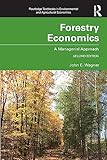Forestry economics: a managerial approach
Material type: TextSeries: Routledge Textbooks in Environmental and Agricultural EconomicsPublication details: Routledge New York 2024Edition: 2ndDescription: xxvi, 594 pISBN:
TextSeries: Routledge Textbooks in Environmental and Agricultural EconomicsPublication details: Routledge New York 2024Edition: 2ndDescription: xxvi, 594 pISBN: - 9781138933149
- 333.75 WAG
| Item type | Current library | Collection | Call number | Copy number | Status | Date due | Barcode | |
|---|---|---|---|---|---|---|---|---|
 Book
Book
|
Indian Institute of Management LRC General Stacks | Public Policy & General Management | 333.75 WAG (Browse shelf(Opens below)) | 1 | Available | 006883 |
Table of content:
1.Introduction 2. Production Systems 3. Costs 4. Revenue 5. Profit 6. Capital Theory: Investment Analysis 7. The Natural Resources Management Puzzle 8. Risk 9. Estimating Nonmarket Values 10. Supply and Demand 11. Market Equilibrium and Structure 12. Taxes 13. Developing Business Plans
[https://www.routledge.com/Forestry-Economics-A-Managerial-Approach/Wagner/p/book/9781138933149?srsltid=AfmBOopa3XCCVHJNMMOvA07scBLpVWn70aiWCgxOp9f6O7GqKDmq5Mpt]
Forestry Economics introduces students and practitioners to the economics of managing forests and forest enterprises. The book adopts the approach of managerial economics textbooks and applies this to the unique problems and production processes faced by managers of forests and forest enterprises.
What many future forest and natural resource managers need is to understand what economic information is and how to use it to make better business and management decisions. John E. Wagner draws on his 30 years of experience teaching and working in the field of forest resource economics to present students with an accessible understanding of the unique production processes and problems faced by forest and other natural resource managers.
The second edition has been updated to include:
Expanded discussion of compounding, discounting, and capital budgeting, as well as an expanded discussion of when to replace a capital asset that has (i) costs but no direct revenue stream such as a machine; (ii) costs and a direct annual revenue stream such as a solar array; or (iii) costs and a periodic revenue stream illustrated by the forest rotation problem.
New practical examples to provide students with applications of the concepts being discussed in the text, most notably on New Zealand and a Radiata Pine (Pinus radiata) Plantation.
A brand-new chapter that develops business plans for for-profit businesses to illustrate how a business plan is derived from the economic information contained within the Architectural Plan for Profit and how it can be used to make business decisions about continuing to operate a business or to start a new business.
This textbook is an invaluable source of clear and accessible information on forestry economics and management not only for economics students, but also for students of other disciplines and those already working in forestry and natural resources.
(https://www.routledge.com/Forestry-Economics-A-Managerial-Approach/Wagner/p/book/9781138933149?srsltid=AfmBOopa3XCCVHJNMMOvA07scBLpVWn70aiWCgxOp9f6O7GqKDmq5Mpt)
There are no comments on this title.
